|
"There's an attitude that the female genitalia do not exist and should not be seen, even by a woman: for the sake of her dignity, she should not even know about it." —Catherine Breillat
In its original meaning, pornography was literally "writing about prostitutes," from the classical Greek roots πορνη (prostitute) and γραφειν (writing). Πορνη started as a euphemism and literally meant '(something) sold.' It is related to the verb περνημι meaning 'to sell.' It derived from a Greek term for men who chronicled the well-known "pornai," or skilled prostitutes of ancient Greece. In more modern times, the term was adopted by social scientists to describe the work of men like Nicholas Restif and William Acton, who in the 18th and 19th centuries published treatises studying prostitution and proposing to regulate it. The term retained this meaning in the Oxford English Dictionary until 1905.
The term then came to mean writing about anything sexual, especially in a base manner, when the creation, presentation, or consumption of the material was for sexual stimulation. The term now refers to sexually related material of all kinds, both written and graphical. The term "pornography" often has negative connotations of low artistic merit, as compared to the more esteemed "erotica". Erotica from the Greek Eros, "love," are works of art, including literature, photography, film, sculpture, and painting that deal substantively with erotically stimulating or arousing descriptions. Erotica is rather a modern word used to describe the portrayal of human sensuality and sexuality with high-art aspirations, differentiating such work from commercial pornography.
The line between erotica and pornography is a fine one and easily blurred.
Whether or not an instance of erotic art is obscene depends on the standards of the community in which it is displayed. If the three great monotheistic religions of the world hadn't spent so much time moralising sex, one might not see anything intrinsically wrong with a life of pornography. However, such is not the case in the world today.
In the United States, the 1973 ruling of the Supreme Court of the United States in Miller v. California established a three-tiered test to determine what was obscene - and thus not protected, versus what was merely erotic and thus protected by the First Amendment.
Delivering the opinion of the court, Chief Justice Warren Burger wrote, "The basic guidelines for the tier of fact must be: (a) whether 'the average person, applying contemporary community standards' would find that the work, taken as a whole, appeals to the prurient interest, (b) whether the work depicts or describes, in a patently offensive way, sexual conduct specifically defined by the applicable state law; and (c) whether the work, taken as a whole, lacks serious literary, artistic, political, or scientific value."
Sexually explicit material (video, photography, creative writing) presents sexual content without deliberately obscuring or censoring it. The term sexually explicit media is often used as euphemism for pornography. It includes un-simulated sex acts, sexual intercourse, and uncovered genitalia.
The term is not very specific, and what is or is not sexually explicit varies from culture to culture. Visual exposure of the penis or vulva and surrounding pubic hair are widely considered sexually explicit, un-obscured sexual intercourse universally so. Some also consider certain language or writing (authentic reports or fiction) to be sexually explicit.
While some observers often label all sexually explicit material as pornography, this is not generally accepted, as it does not examine the intent behind the material. For example, sexual intercourse may be shown to illustrate principles of safe sex and as such be a component of liberal sex education, or in a film it may be part of a complex story and be viewed to contribute to overall plot development.
The movie camera has been used for pornography throughout its history, but pornographic movies were for most of that time typically available only by underground distribution, for projection at home or in private clubs.
Pornographic movies were widespread in the silent movie era of the 1920s, and were often shown in brothels.
More permissive legislation permitted the rise of "XXX-rated" movie theatres in the United States in the 1970s. There was also a proliferation of coin-operated "movie booths" in sex shops that displayed pornographic "loops" (so-called because they projected a movie from film arranged in a continuous loop).
With a million dollar business behind it, it is easy to define "real" pornography as what it is…but what about "sexually explicit" scenes in cinema?
Alluring photographs capture the physical heat, while a perceptive analysis examines every crucial aspect of cinematic eroticism. Some of the films, such as Double Indemnity, show sex as an irresistible, dangerous trap; others, including Tom Jones, wittily suggest desire through dialogue and visual metaphors. A number of works, from Ai No Corrida to the homoerotic Caravaggio, shocked, challenged, and disturbed. Also on display are the frank, uncompromising approach of European directors such as Bertolucci, Bu˝uel, and Almodˇvar; the darker side of on-screen sexuality including S/M (The Night Porter); and taboo subjects such as incest and necrophilia—implied in Hitchcock's masterpiece, Vertigo.
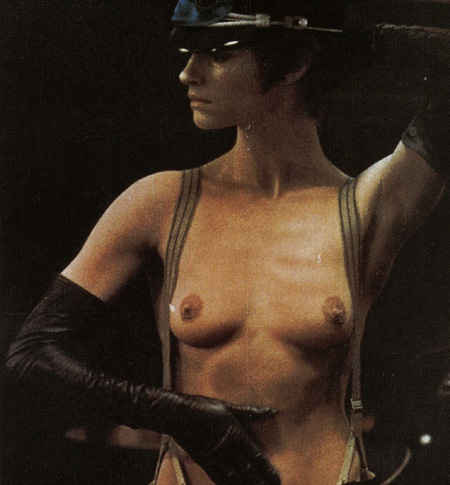 |
According to Catherine Breillat, "Pornography is the sexual act taken totally out of context, and made into a product for consumption, by using the most debased feelings or emotions of people, when in fact in daily life sexual acts are surrounded by emotions, consideration for the partner, pleasure and so on, which do not come within the pornographic depiction. So pornography as an industry is a prostitution of the common and valuable human emotions and acts which everybody does in their day-to-day life. Pornographic cinema doesn't exist - there's no cinema in pornographic films. There are no actors, because they don't carry any emotions, they don't carry character. They are just flesh. And she continues: "Pornography doesn't really exist. It's the invention of a puritanical society, what produces pornography as such is the way our society looks at the product: this feeling of obscenity exposes women and reduces her capacity to occupy positions of influence in our society. We live in a pornocracy (as opposed to a democracy). Women have two kinds of power, historically: as the courtesan and as the whore. The courtesan seduces men without giving them sex, exterminating the man without giving him a single taste of her body. In our society, women are condemned to be either courtesans or whores."
But the reality is that porn is sleazy. That's why consumers like it and why some people aspire to be in it. It's dirty and secretive, beyond the pale and completely unacceptable to social or Judeo-Christian norms. It is taboo, forbidden. In a world that has become increasingly commoditized and sterile, sexual exploration may well be the last frontier, offering both adventure and self-knowledge. As soon as porn becomes squeaky clean and acceptable, a family pastime, it will lose its allure and significance for those who want to use it as a tool of masturbation, rebellion or self-expression.
And sex sells! It is used in advertisement and certainly brings audiences to film theatres.
Nudity however is something very natural, and sex is definitely beautiful and very enjoyable. The question is: how much do we have to see on screen, is necessary for the plot and how is it done?
I believe that is the fine line, that can easily be crossed, something that can easily shock or disturb an open-minded audience and cause a feeling of being uncomfortable by raising the question: Why do we have to see that now?
Sexy and erotic images in film scenes can be displayed in many varieties and kinds of films. Sexual scenes may appear in art-house films, horror/slasher films, erotic dramas, foreign-language films, and mainstream films. They may be 'old-fashioned,' risquÚ, blatant, mature, PG-13, excessive, suggestive, cheap, exploitative, outrageous, innovative, infantile, soft hued and soft-focused, campy, voyeuristic, trashy, sensual, highly-charged, symbolic or visually metaphoric, carnal, highly-choreographed and artsy, prurient or soft-core NC-17. Erotic films, unlike pornography, do not have as their sole purpose the explicit and graphic display of sex and nudity. Erotica sometimes is explicit, but can often be teasing, intriguing, stylised, unique, and imaginative. However, trends in recent art-house films (that are unrated) suggest that simulated sex is becoming more explicit, un-simulated sex - bordering on pornographic! Although most theatrical releases are often edited to obtain an R-rating, the DVD releases include the 'director's cut', with unrated, explicit extras material.
In the context of the sexual revolution that has evolved in filmmaking, therefore, one must ask: "What makes an influential, ground-breaking, and/or memorable erotic (or sexual) scene in a film?" These are at least some of the ingredients for a great erotic or sexy scene: The ground-breaking or controversial nature and influence of the film scene, the degree to which the sex is gratuitous or not, the unique use of nudity or non-nudity, the presence of a semi- or un-clothed celebrity or actor/actress, the lush photography, the level of sensuality generated, the build-up to the scene in question, the scene's degree of fantasy or realism, the revelation of character, the integration of the scene into the entire film's plot and the passion or emotion of the relationship. And as time goes by, the tolerance of audiences seems to have grown quite considerably. A few examples that caused scandals at their release are:
The May Irwin Kiss (1896) was the first then "pornographic" event on screen.
This very first kiss on film was between a Victorian couple seen in this Edison kinetoscope in a filmed scene from the stage play The Widow Jones - the titillating short 20-second film loop, with a close-up of a kiss ("the mysteries of the kiss revealed"), was denounced as shocking and pornographic to early moviegoers and caused the Roman Catholic Church to call for censorship.
Daughter of the Gods (1916) Australian-born swimming and diving champ Annette Kellermann caused a stir when she was seen naked with her flowing hair under a waterfall - she was the first female star to appear nude on screen; this controversial film was also the most expensive film of its decade at $1 million.
Un Chien Andalou (1929, France) A shocking, and provocative surrealistic film, only 17 minutes long, by Salvador Dali and Luis Bu˝uel, that was banned in various countries, with its infamous eyeball razor-slashing scene, and these sexual assault images of a man's (Pierre Batcheff) hands lustfully fondling the breasts of a clothed and then naked woman (Simone Mareuil); in the next image, the breasts disappeared and were transformed into buttocks - which the man continued to palpate.
Morocco (1930) In her Hollywood debut film (with Paramount and von Sternberg), Marlene Dietrich targeted her sexuality toward both men and women; as Amy Jolly, she scandalously wore a sexually-ambiguous men's tuxedo and top hat as a performer in a North African cabaret club - in an early scene she sang "Quand L'mour" with smoky eroticism, took a flower from the hair of a young lady in the audience, inhaled it suggestively, and then kissed the woman full on the mouth - one of the earliest (if not the first) female-to-female kiss; after wild applause, the bisexual (or androgynous) chanteuse tossed the flower to foreign legionnaire Tom Brown (a young Gary Cooper); later, the sultry Dietrich also performed the top-hat and white- tailed "What Am I Bid for My Apples?" - she sold one to Tom, who bit it lustily (filmed in close-up), and then let him light her cigarette (a veiled symbol for intercourse).
Tabu: A Story of the South Seas(1931) A lush tale of ill fated) native South Seas love (with flower-garlanded, bare-breasted native dancers) and the breaking of a sexual taboo, in this documentary-styled film of island life.
The Blue Angel (1930) (aka Der Blaue Engel) Director Josef von Sternberg's unrestrained first film with the legendary Marlene Dietrich in a star-making role - with a plot that would often be repeated in their collaborations; a meek and repressed teacher Professor Immanuel Rath (Emil Jannings) was tempted, seduced and destroyed by a sensual, carefree, and carnal entertainer named Lola Lola (Marlene Dietrich) at the Blue Angel nightclub, when she sang a throaty rendition of "Falling in Love Again" astride a barrel on stage - in top hat, with gartered stockings on bare thighs.
These are certainly examples that would certainly not irritate any audience nowadays, and might not even be labeled "erotic" anymore.
Back to the question, what is pornographic and what is erotic?
The Piano (1993) by Jane Campion is certainly one of the most erotic films made during the last years.
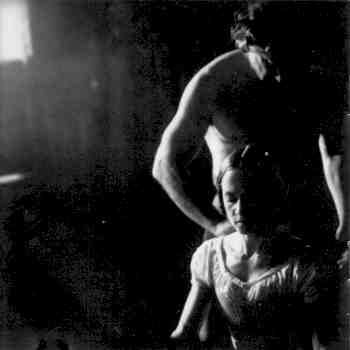 |
Ada is a mute who has a young daughter, Flora. In an arranged marriage she leaves her native Scotland accompanied by her daughter and her beloved piano. Life in the rugged forests of New Zealand's South Island is not all she may have imagined and nor is her relationship with her new husband Stewart. She suffers torment and loss when Stewart sells her piano to a neighbour, Baines. Ada learns from Baines that she may earn back her piano by giving him piano lessons, but only with certain other conditions attached. She will earn her piano back, black key by black key, if she will tolerate his indecent sexual advances while she plays She is imprisoned and Baines begins to use her in a one-sided relationship located somewhere between rape and forced prostitution. Despite the awful crudeness and the indignity of it all, however, we begin to sense Ada's willingness as Baines ups the stakes, more keys in exchange for more sexual favours from Ada. He breaks into Ada's sublimated autoeroticism with a brutal display of his own and then both are imprisoned by their passion for each other. Still, what is going on has all the overtones of sado-masochistic domination with the unwilling female victim eventually exploding into passionate response to this repulsive and coercive man. For some feminists this kind of interchange is the most hated re-enactment in the repertoire of sexual narratives. It reinforces the male fantasy that what a woman wants and finds exciting is sexual brutality from a primitive man. Campion has certainly played out this masochistic and Freudian version of female sexuality to demonstrate another variation of imprisonment and freedom, and at the same time has created an atmosphere full of uncontrollable sexual passion.
The husband satisfies himself in some strange way by watching – at least he does not interfere. But after this he unsuccessfully attempts to rape his wife and then imprisons Ada and Flora in the homestead by nailing shut the door and windows. Now possessed by an uncontrollable sexual passion, Ada begins to fondle her daughter as Baines had fondled Ada. Campion had earlier shown the mother and daughter to us in overexcited tickling play emphasizing their libidinal bond that shut everyone else out – particularly the impotent husband who watches them. Now she has her heroine move to the edge of overt sexual contact/sexual abuse of her daughter. Ada wakes in apparent horror. Losing control, she turns to her husband to exorcise her sexual passion in a controlled way. She will be sexual with him but he must accept her touches without touching her. Here Campion plays another Freudian card and has Ada's scented hand stroke between her husband's buttocks. It is not sexual attraction, but the classic victim as victimizer.
But Ada is still in love with Baines and he is now more important than her self-expressive piano – as she proves by removing a key, marking it with her promise of love, and pressing Flora to take it to him. Feeling the loss of her mother's love as bitterly as Stewart, Flora, the evil spirit, takes the telltale key to him rather than Baines. The piano has lost a key and now the wife will lose her finger. Here the archetypes of the unconscious resonate with fantasies of ritual mutilation. Campion has shown us a symbolic clitoridectomy, Ada cut off from the flesh of her passion. The scene that is so objectionable is essential to Campion's narrative. The punishment symbolically fits the sexual crime. Castration of women by clitoridectomy was once prescribed by western physicians as a treatment for excessive masturbation and as a religious ritual continues to this day for millions of African women. Campion's scene, whether feminist or not, speaks eloquently of patriarchy's brutal denial of female passion in all its liberating possibilities.
Men use sex to hurt women. An argument can be made that men have to hurt women, diminish them, in order to be able to have sex with them–break down barriers to their bodies, aggress, be invasive, push a little, shove a little, express verbal or physical hostility or condescension. An argument can be made that in order for men to have sexual pleasure with women, women have to be inferior and dehumanised, which means controlled, which means less autonomous, less free, less real. Under this aspect, The Piano could be considered to be pornographic, because in pornography we literally see the will of women, as men want to experience it. This will is expressed through concrete scenarios, the ways in which women's bodies are positioned and used. However it is the exact opposite of pornography. Stewart, unable to be a man with his strong wife, is now sexually aroused by her victimized condition and undoes his pants. But when Ada's eyes open, Stewart is stopped in his tracks, and hears the voice that sounds in her mind. He must let her leave with Baines. Their belongings, including the piano, are placed in a Maori vessel and they set off from the beach in a spectacular scene. When they are at sea, Ada unexpectedly tells Baines through Flora that she wants the piano thrown overboard. He reluctantly complies and when the piano is heaved into the sea it begins to sink like an anchor. And like an anchor it has a rope, which snakes around Ada's leg and pulls her out of the boat and under the sea. The piano that liberated her passion is now to be the cause of her final imprisonment. It is an appropriate tragic ending of the melodrama – or so Campion wants us to think, as she prolongs the scene in slow motion. But Ada suddenly resists, regains the surface, and is saved. Her inner voice tells us that it was not she who chose to live but the imprisoning iron will that is the other. The film ends with ambiguity. Baines, Ada, and Flora move to a town where Ada, fitted out with a metal finger, gives real piano lessons, and is learning to speak. Baines is there to love her and so is Flora. But Ada dreams of still being attached to the piano in the deep sea. Here we return to ThePiano's deep structure of imprisonment and freedom. Imprisoned by silence, by passion, by bars, by men, by New Zealand, by Victorian custom, and by the will that was not her own, Ada escapes to freedom and finds her voice. But in that escape she loses her finger, her piano, her passion, and her genius. Caught, finally, in the ordinariness of a life without art, she dreams of the imprisoning silence of death.
I have used this example to show the necessity of how sex in any form can be used in cinema (no matter how real and close-up) if it serves the purpose of symbolising and abstraction of a deeper meaning. This might appear as this fetishizing of the female body, its sexualization, and dehumanisation, and can be very irritating and often shocking or annoying. However in pornography, any fetishizing of the female body, its sexualization and dehumanisation, is always concrete and specific; it is never abstract and conceptual.
Sex in cinema is very often used as a form of political power and an expression of fascism in form of rape, Sadism, or even so-called "bestiality" (sex with animals) like inPadre Padrone by Vittorio and Paolo Taviani (1977),
the true story of the life of Gavino Ledda, the son of a Sardinian shepherd, who managed to escape his harsh, almost barbaric existence by slowly educating himself, despite violent opposition from his brutal father.
A different kind of symbolism through bestiality is shown in The Beast (1975) by Walerian Borowczyk. In this story, a young nobleman with an unusually strong interest in horse breeding is being prepared to marry the wealthy niece of an American Cardinal. (Noble families, which are growing impoverished, try to marry off their younger generations to the heirs of wealthy commoners.) When the girl arrives at the nobleman's family mansion the day before the wedding, she is shown around the house and its treasures and is told the story of an ancestor's legendary battle against a beast. That night, she dreams of an erotic encounter with a man/beast, which culminates in the death of the beast. On awakening, she finds that she has been in bed with her fiancÚ, who is now dead. When mysterious bandages on his person are removed, he is seen to have a tail and one hand, which has turned animal-like.
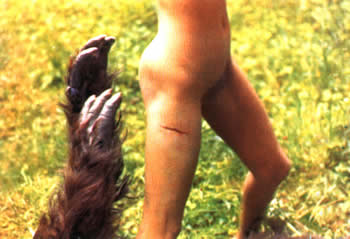
It is very obvious, that this film (like many other of this kind) is based on La Belle et la Bŕte (Beauty and the Beast) (1941) by Jean Cocteau, derived from the classical French fairytale. Beauty has an Oedipal love for her father, which must be broken for her to become fulfilled as an adult human being. This is the story of transference of love from the inappropriate father to a more appropriate mate, and also about the child's fear of sexuality. The father's theft of the rose symbolizes his particular love for his youngest daughter, and anticipates her eventual sexual maturity, since the broken flower is a symbol for the loss of virginity ("deflowering"). The beast of sexuality, which appears at the moment of the theft, represents the anxieties both the loving parent and the child feel about the onset of adult sexuality. (Note that the Disney version, while altering much else, retains the Oedipal attachment of the daughter to her father.)
However, the Beast's threat proves to be illusory; rather than a ferocious, destructive creature, he is a loving and tender mate. But she does not immediately realize this. She remains torn between her father and the Beast, wishing to return to her father's side (many versions include a magic mirror through which she witnesses her father's distress); only when she is removed from the Beast's presence and realizes his suffering does she recognize where her appropriate love lies. She must return to her father's house to resolve her Oedipal ties to her father before sex, previously repugnant, can become beautiful.
Many fairy tales deal with this oedipal struggle; however, "Beauty and the Beast" is unusual in that it represents the oedipal attachment as normal, positive, capable of coexisting with the love of the spouse - note the difference between this and some of the Cinderella versions.
One can note here, as in many other folkloric images, the association of sexuality with the bestial. In many European versions of this story, the "bestial" form is that of a snake - a phallic creature. The story works off of human duality as animal and mind (especially noted in the story's ancestor, Cupid and Psyche); the marriage of Beauty and Beast is a symbol of the control of the id (animal, sexual passions) by the superego (socially constrained intellect). Quite surprisingly, this prototype is used in many films and, to make things difficult again, a lot in pornography.
Cat People (1942) by Jacques Tourneur, redone by Paul Schrader (1982) goes from bestiality a step further into incest. The Cat People originated way back in time, when humans sacrificed their women to Leopards, who mated with them. Cat People look similar to humans, but must mate with other Cat People. We follow brother and sister - who seem to be the only ones of their kind left, combined with a young woman's sexual awakening that brings horror when she discovers her urges transform her into a monstrous black leopard.
A similar version can be found in Sleepwalkers (1992) by Mick Garris, based on the book by Stephen King, where the incest takes place between mother and son in a tale of modern-day vampires who prey on virtuous young women. This brings us right away to Vampirism.
Of all the assorted "monsters" of fiction, the only one overtly associated with sex is the vampire. That's ironic, since the vampire of folklore was not a sexually attractive figure; he was a dead man who fed on blood, a monster about as attractive as a zombie. Bram Stoker changed all that with his novel, Dracula. Stoker used the vampire as a metaphor for the Victorian view of sex as innately dangerous. In Dracula, sex with the Count transformed women into seductive sirens and horrific baby killers – the opposite of the Victorian ideal of chaste and nurturing womanhood.
A beautiful example for a highly erotic film is Francis Ford Coppola's Dracula(1992), in the adaptation of Dracula by James Hart and Coppola; much is restored from Stoker that had lost focus and utility in previous adaptations.
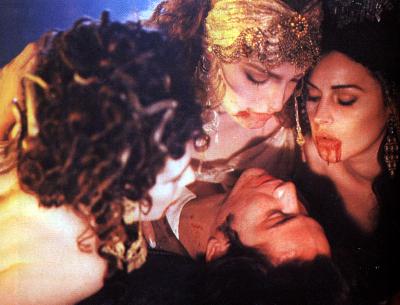
For example, the delineation of the flirtatious Lucy Westerna and her three suitors as foil to the more chaste Mina Harker is far closer to Stoker's original conception than any subsequent adaptation. Lucy's character is 'flawed' in a way that makes her fatally vulnerable to the vampire. She is a woman whose sexuality is under very imperfect control. Lucy would very much like to marry all three of her suitors and feels rather constrained by social mores. In sacrificing Lucy, the four men purge not only their fear of female sexuality generally, of which she is the monstrous expression, but also–and more importantly–their fear of their own sexuality and their capacity for sexually-prompted violence against each other. The most passionate love scene in the film is between Mina and Dracula. Many have argued that Dracula's biggest danger to Victorian society was that he unleashed female sexuality. But rather than being a story about women becoming reconciled to sexless men, Coppola's film takes female sexuality as a pleasure of the text.
Hammer had understood this years earlier and started to enrich his Dracula films slowly but surely with more (unnecessary) nudity and sex scenes, turning some of them indeed into nothing but rather tasteless pornographic movies.
Sex scenes and orgies are often used for different and individual reasons. If I were to name the first pornographic film masked as art, I would mention Caligula (1979) by Tinto Brass. The rise and fall of the notorious Roman Emperor Caligula, showing the violent methods that he employs to gain the throne and the subsequent insanity of his reign - he gives his horse political office and humiliates and executes anyone who even slightly displeases him.
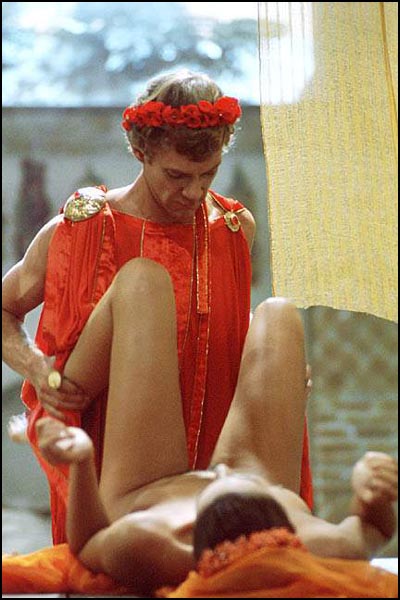
He also sleeps with his sister, organises elaborate orgies and embarks on a fruitless invasion of England before meeting an appropriate end. There are various versions of the film, ranging from the heavily- truncated 90-minute version to the legendary 160-minute hardcore version, which leaves nothing to the imagination (though the hardcore scenes were inserted later and do not involve the main cast members, which says a lot).
But even the more explicit orgies in cinema do not have to be pornographic.
Stanley Kubrick's Eyes Wide Shut (1999) is anything but pornography, in spite of all the discussions and objections. Much has been written about the sexual content of Eyes Wide Shut, which is extreme but not excessive or pornographic in nature. Kubrick presents sex and nudity in a manner that is more disturbing than erotic. The underlying current of uncertainty and danger lends an unsettled aura to the most explicit scenes. The first time we see a nude woman, she is lying sprawled in a chair, having overdosed on drugs. Later, when Bill and Alice are engaging in foreplay, she is clearly abstracted. And, during the soon-to-be infamous orgy sequence, all of the participants are masked and many are wearing sinister costumes that consist of hooded, black capes and tuxedos. This entire portion of the film has a gothic feel to it.
It's impossible to mention the orgy without discussing the digital manipulation demanded by the MPAA for Eyes Wide Shut to have its classification reduced from the box-office killing NC-17 to an R. Although Kubrick tentatively approved the concept of using digital figures to block out 65 seconds of certain sex acts, he might have balked at the final result. While the computer generated images look adequate from a realistic point-of-view, their placement is awkward, and it becomes obvious that they were inserted to hide screen images.
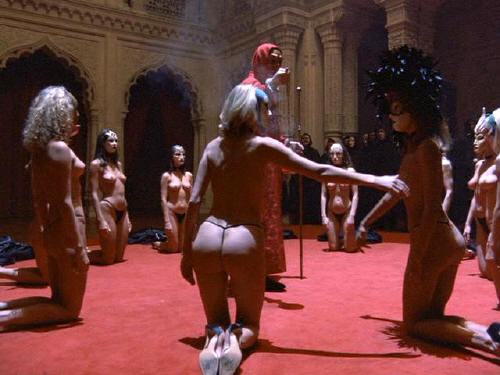
The key theme in Eyes Wide Shut is one near and dear to Kubrick's heart: the dehumanisation of society. This is a concept he has returned to repeatedly during his career (most obviously in 2001, A Clockwork Orange, and Full Metal Jacket). Here, Kubrick has something to say about the causes and effects of depersonalised sex. The orgy scene is the fulcrum of Eyes Wide Shut, and, during its course, all of the copulating couples are masked and costumed. They cannot kiss, see each other's faces, and, for the most part, they do not speak. Sex is normally the most intimate means of human interaction, yet here it is reduced to a ritualistic, almost creepy form of gratification. The men and women involved in this tableau must hide their faces because being recognized could cause them untold damage in the current social and political climate. There is freedom in anonymity, but also isolation and a complete death of emotion.
Pasolini's Sal˛ o le 120 giornate di Sodoma (1975) is a disturbing but in many ways decidedly anti-erotic film. Sal˛ approaches sexuality entirely from its darker exploring the instinctual forces regarded by the author as governing human life and variously expressed, perverted and repressed in different historical and social circumstances. Its theme is not erotic pleasure as such but the perversion and subordination of love relationships to those of power. What makes the film disturbing is the way it plays on the audience's uncertainties as to the boundaries separating normality and perversion, pleasure and distaste. The film is set in the last days of Fascist rule in Italy, in a period when fascism had ceased to be either popularly supported or politically viable, and when Mussolini's puppet republic was sustained only by German arms and the fanaticism of the Fascist 'hierarchs'. It is significant - and the point would not be lost on an Italian audience - that the only place-names mentioned in the film are Sal˛ itself (headquarters of the puppet republic) and Marzabotto (site of a notorious wartime massacre by the Nazi occupying forces).
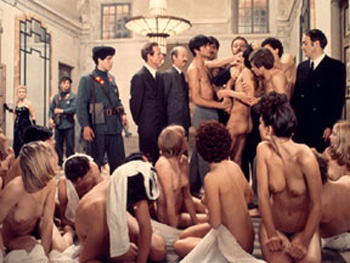
The film thus situates its subject matter firmly in relation to Fascist political power - not so as to claim an historical connection between fascism and sexual orgies but rather to propose an analogy between two forms of 'anarchy of power', political and sexual. Just as fascism and Nazism can be seen as a form of the use of force and violence unconstrained by Law and thus as an anarchy of the powerful against their victims, so the world of the Marquis de Sade is seen as an anarchy of violence in sexual relations. But just as fascism is not really anarchy, because freedom to infringe the law is reserved to a small class at the expense of the rest, so the Sadian orgy is not an expression of freedom either but takes the form of a brutal tyranny. Sal˛ is an adaptation of Sade's notorious book The 120 Days of Sodom. It is important, however, to signal a major difference between the two works. Sade's novel is about pleasure, thus inextricably connected with power and with death; Pasolini's film is almost exclusively about power, death and degradation, and hardly about pleasure at all. In Sade's writing cruelty and the death wish appear as a component of sexual pleasure, and when the pleasures of life are exhausted the supreme pleasure - the supreme orgasm - comes in receiving and administering death. But it is crucial that it is the telling of stories that exists in the film, and not their realisation. This is the ghostly side of stories - that they are told after the event. It ties in with the way the word 'fantasy' sometimes connotes a negative state. The Masters in Sal˛ in fact need stories because they are dead. They have transgressed humanity to the point where they're out of touch with their own stories. They are divorced from life
If any film is not pornographic, than it is Sal˛, in spite of all the storms of controversy and scandal that were whipped up around it, which once again shows, how difficult is, to categorize a film. Pasolini himself said about Sal˛:
"This film is a cinematographic transposition of Sade's novel The 120 Days of Sodom. I should like to say that I have been absolutely faithful to the psychology of the characters and their actions, and that I have added nothing of my own. Even the structure of the story line is identical, although obviously it is very synthetised. To make this synthesis I resorted to an idea Sade certainly had in mind - Dante's Inferno. I was thus able to reduce in a Dantesque way certain deeds, certain speeches, certain days from the whole immense catalogue of Sade. There is a kind of 'Anti-Inferno' (the Antechamber of Hell) followed by three infernal 'Circles': 'The Circle of Madness'; 'The Circle of Shit', and 'The Circle of Blood'…… We should not confuse ideology with message, nor message with meaning. The message belongs in part - that of logic - to ideology, and in the other part - that of irrationality - to meaning. The logical message is almost always evil, lying, and hypocritical even when very sincere. Who could doubt my sincerity when I say that the message of Sal˛ is the denunciation of the anarchy of power and the inexistence of history? Nonetheless put this way such a message is evil, lying, hypocritical, that is logical in the sense of that same logic which finds that power is not at all anarchic and which believes that history does exist. The part of the message which belongs to the meaning of the film is immensely more real because it also includes all that the author does not know, that is, the boundlessness of his own social, historical restrictions. But such a message can't be delivered. It can only be left to silence and to the text. What finally now is the meaning of a work? It is its form. The message therefore is formalistic; and precisely for that reason, loaded infinitely with all possible content provided it is coherent - in the structural sense."
A similar way of expressing political power through sex (although not as strong and brilliant) is present in smaller sex scenes of films like American History X (1998) by Tony Kaye, O Thiassos, (The Travelling Players ) by Theo Angelopoulos (1975) and in the movie Il Portiere di notte aka The Night Porter by Liliana Cavani (1974). The Night Porter is ultimately an exploration of human behavior at its most extreme–as well as the indelibility of such behavior. Most disturbing to the viewer is its refusal to limit certain activities or character traits to specific character types. Had this been a more traditional exploration of Nazi corruption, perhaps the film would have been more palatable to some. But here, there is ultimately no difference between Nazi and Jew; between man and woman; between gay and straight. All that matters in the end is the experience of harsh sensations. Indeed, while Max and Lucia are the only characters willing to act on these feelings, no one is shown to be unaffected by their experiences. Max's fellow officers allow the evidence they gather to be used against them in mock "trials," pathetically claiming that this acts as a form of therapy–that by "accounting" for their crimes in this manner, they are purging themselves of guilt while receiving no actual consequences. It is only when Max's own form of play-acting begins to threaten them that they show any real concern, however. The viewer of the film is given no "innocent" character to identify with and can only escape by choosing not to take the journey at all.
The question still hangs: is this "exploitation" and is this pornography of the lowest kind? In order to arrive at an answer, one must satisfactorily define the term. Most moviegoers would agree that exploitation films as they know them attempt to provide vicarious thrills through the use of sex and/or violence. Yet while The Night Porter contains both of these elements, one would be hard pressed to argue that any semblance of a thrill is contained herein. There's considerable nudity, but any potential eroticism is nullified by dingy, gray lighting and the cold backdrops of a concentration camp, and the passion between Max and Lucia is punctuated by the (sometimes excruciating) details of their pain/pleasure relationship. Most of the film's violence takes place off screen–and what's left falls nowhere near the "action" category. The film comes closest to traditional exploitation in a flashback sequence -Lucia, dressed only in pants and suspenders, sings and dances for the Nazi officers, cabaret-style.
Cavani's film was released before such Nazi torture epics as Ilsa, She-Wolf of the SS and a string of similar European imports hit U.S. screens. It has been argued with considerable validity that The Night Porter helped pave the way for their very existence, and no matter what can be seen in it, I consider it to be pornographic. Pornography is after all a form of dehumanization.
A subject difficult to be discussed is paedophilia. Louis Malle was one of France's most prestigious filmmakers. Pretty Baby (1978) is an excellent place to see the so-called European sensibility at its best, a mainstream studio release that not only couldn't get made today, its makers would be arrested if they even tried to film it.
Louis Malle tackled a social taboo and made 12-year-old Brooke Shields a star with this controversial examination of child prostitution in turn-of-the-century New Orleans. Violet (Shields) is the daughter of a prostitute who works at one of the brothels in New Orleans' legendary red-light district, Storyville. One day, photographer Ernest Bellocq (Keith Carradine) arrives at the brothel to take photos of the prostitutes and becomes fascinated with Violet, who is fast approaching her 12th birthday and a subsequent initiation into prostitution. When her mother moves to St. Louis in search of marriage and respectability, Violet determines to marry the much older Bellocq. Malle infuses the potentially lurid subject matter with a lyrical beauty that brings humanity to his characters and story, with the assistance of a sensitive script by Polly Platt and superb cinematography by Sven Nykvist.
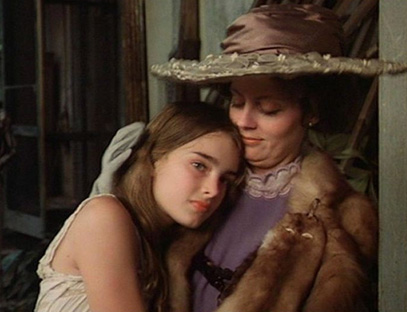 |
Was the Shields nudity sexual or not? I would say "no", and after all Hollywood got away with a twelve-year-old masturbating with a crucifix in The Exorcist by William Friedkin (1973), which also does not fall into the category of pornography and assumingly not under the law of paedophilia.
An interesting film fact by the way is Polly Tix in Washington (1932). An example of a 15 minute child exploitation film, one of the Baby Burlesque shorts (with toddlers playing adult roles), featuring four-year-old Shirley Temple (in only her second film role) as Polly Tix - a high-priced call girl/prostitute sent by corrupt officials to influence a backwoods politician; films such as this and others led to an outcry for more wholesome films.
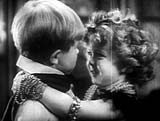
Paedophilia itself is not a legal term, as it describes no act. In modern western societies, sexual acts between adults and prepubescent children are usually considered both a taboo and a crime; historically, in Western societies, sex was considered a privilege of marriage, and marriage was allowed as long as there was parental consent. It was fairly common for adolescent and in some cases prepubescent females to marry adult men, and it is hard to believe that sexual activity was absent in all cases. Changes in the reason for marriage from improving social status to love, along with anti-child sex advocacy during the industrial revolution led to laws preventing this in most places.
Western societies have also, until the 20th century, considered attraction to the body of prepubescents as acceptable, as evidenced by acceptance of artwork involving nude and erotic depictions of children (for example: Lewis Carroll). During the 20th century, attempts were made (sometimes successfully) to destroy such artwork, make it illegal, or remove it from public libraries. Though such artwork can sometimes be considered legal, social pressure has prevented creating new forms of such artwork and ownership of such artwork. Sex between children and adults was condoned and often encouraged by Polynesians and other cultures, especially matriarchal societies. The reason for this was because these societies revered fertility and motherhood and did not attempt to control sex. Western influence and domination has eroded their open views about sex. Which throws up the question: What about Nabokov's Lolita on the screen?
Lolita was done twice, 1962 by Stanley Kubrick and 1997 by Adrian Lyne, and it still is considered by some to be obscene, to others a masterpiece of fiction and cinema. The term Lolita has come to be used to refer to an adolescent girl considered to be very seductive, especially one younger than the age of consent. In the marketing of pornography, it has been used to refer to any attractive woman who has only recently reached, or is still younger than, the age of consent, or sometimes to refer to women who only appear to be younger than the age of consent. For this reason, it is especially worth noting that Nabokov's Lolita is far from an endorsement of paedophilia, since it dramatizes the tragic consequences of Humbert's obsession with the young heroine.
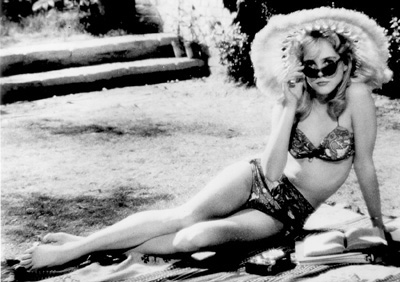 |
For Kubrick, Lolita represented an important advance in the development of a psychological film style. Nabokov's Lolita gave him, for the first time, a novelistic source that constructed its world from inside the mind of a single fictional intelligence. And even though Humbert's imagination can mesmerise the reader with its richness of invention and distortion, Nabokov uses the ironic and often periodic intrusions of his third person "voice" to undermine and transcend his narrator's clever special pleadings. Perhaps one reason why Lolita remained for years after its release Kubrick's most unappreciated and misunderstood early film—why so many critics failed to notice that, like Bu˝uel's Viridiana (1961), for example, it develops a surrealist mise-en-scŔne through a deceptively sparse naturalism—is the strength of its performances. The film's cast develops and improvises so many revealing details of character that its subtle manipulation of mise-en-scŔne might go unnoticed.
Scenes in bedrooms and bathrooms abound in Lolita, as they do in Nabokov's novel, and indicate the film's highly developed use of studio-bound settings to express the comic and tragic modalities of a psychological/sexual content. Within these private chambers of an otherwise public domesticity, where the guilty and repressed secrets of suburbia find both release and purgation, Kubrick develops a visual and musical coherence that binds setting to both character fate and film concept. Throughout much of the film, bedrooms and bathrooms come together in an expression of primal irony. Charlotte, just before she escorts Humbert into her bedroom, makes a point of illustrating her home's old-fashioned plumbing by pulling the toilet chain and synchronizing her vulgar laughter to its flushing. Later, on the morning Lolita leaves for camp, Humbert crawls from his bed and, with the bathroom visible in the background as counterpoint and the theme music rising in pitch, receives Lolita's embrace as she winks and tells him not to forget her. He then goes into Lolita's room to sit on her bed, flanked by innocence on one side (a teddy bear) and vulgarity on the other (Quilty's picture on the cigarette poster), as he reads Charlotte's confession of love. In marriage, Humbert escapes from Charlotte's bed into the bathroom, where he scribbles his secrets in a diary and is pursued by her pouty snoopings into his private life. And in that same bed, Charlotte starts to tell him about her "most ambitious fantasy" as he simultaneously makes love to her body and his fantasy embodied in Lolita's picture on an end table. When he discovers that Charlotte's fantasy also involves Lolita sending her off to boarding school so that she can have him all to herself-Humbert rolls over and contemplates the gun lying opposite Lolita's picture. At the Enchanted Hunters, Kubrick creates a sense of dejß vu as he delivers Humbert and Lolita into a room that mirrors the decor of Ramsdale, with flowered wallpaper in the bedroom and a bathroom in the background with a chessboard floor. Humbert comes out of that bathroom and hovers in a state of cleansed readiness over the sleeping beauty, but alas, she wakes up and sends him Scurrying to the cot. The next morning, Lolita bends over a tired and unshaven Humbert lying in his "collapsible" bed and whispers her dirty secret into his ear. In later scenes, this comic movement within a maze of private passions takes darker and more poignant courses. And more successfully than in any of his previous films, Kubrick demonstrates in Lolita a remarkable talent for directing his actors and developing a profound emotional content within the larger structures of an ironic distance.
Last not least, what about "pornography" in cinema? Talking about prostitution or forms of prostitution, one of the most beautiful and fascinating films is Belle de jour (1967) by Luis Bu˝uel. Severine (Catherine Deneuve) is a beautiful young woman married to a doctor. She loves her husband dearly, but cannot bring herself to be physically intimate with him. She indulges instead in vivid, kinky, erotic fantasies to entertain her sexual desires. Eventually she becomes a prostitute, working in a brothel in the afternoons while remaining chaste in her marriage.
 |
The main character is at once glacial yet erotic – a wife by night and prostitute by day. She is two different people in one body, but Bu˝uel underlines the truth that no person can effectively compartmentalize facets of their life. Crossovers are inevitable, and the harder we try to repress one segment of who we are, the more likely it is to assert itself – forcefully. Bu˝uel ridicules the morals of society by depicting what goes on behind closed doors at the brothel where Deneuve's Severine spends her afternoons. An internationally known gynecologist begs to be punished. A businessman frolics with three girls at one time. Then there are Severine's erotic fantasies, which easily become entangled with her surreal secondary life. In fact, her misguided relationship with a gangster arises out of a hidden desire to flirt with danger. All along, Severine's husband Pierre is blissfully ignorant of his wife's daytime job. He loves her, but wishes she would be more sexually attentive. Meanwhile, a friend pursues Severine tirelessly – until he learns her secret. At that point, the chase loses its allure. After all, where's the fun if the "forbidden fruit" isn't quite so forbidden?
This film bares a true taste of eroticism without showing any nudity and vulgarity. In fact, even though its main character, Severine, is a prostitute and we witness several confrontations with her clients, the act of intercourse is never shown, only suggested. The nudity is discrete, as at most we see Severine's bare bottom through a black, thin robe.In this film,Bu˝uel provedonce more that heunderstood the hypnotic intensity with which humans consider their own fantasies.
Nagisa Oshima's controversial film Ai no Corrida aka In the Realm of the Senses, based upon a true incident in 1930s Japan, effectively skirts the borderline between pornography and art. The story concerns servant and former prostitute Sada Abe (Eiko Matsuda) who becomes sexually obsessed with her employer Kizicho (Tatsuya Fuji), a businessman, after seeing him making love to his wife. After making love to Sada, Kizicho becomes obsessed with her as well. As their lovemaking becomes more and more intense, they find themselves unable to separate themselves from each other, until every waking hour is spent in more and more dangerous sexual acts with Sada becoming more and more of the aggressor. Finally, for the ultimate in eroticism, Kizicho agrees to be strangled during sexual ecstasy for the ultimate in orgasmic fulfillment.
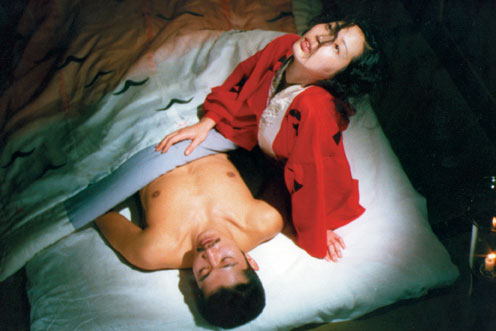 |
The French title, 'L'Empire des sens' plays on the title of Roland Barthes's influential response to Japan as an Empire of empty Signs, all ritual and surface with no meaning or depth. Its Japanese director, Oshima Nagisa, responds to Barthes with a film which focuses literally on sexual rituals and material surfaces, on skin contact, but one which allows for endless interpretations, spinning meanings at a dizzying rate. For the French word, sens - like the English word, sense - refers not only to the five senses of sight, hearing, touch, smell and taste but also to meaning in the sense of import, connotation. However, the Japanese title of the film speaks neither of empires nor senses. It speaks of love and death, Eros and Thanatos. Ai no corrida - the Corrida of Love - links love to the bullfight, the ritualised fight to the death between the matador and the bull. This title brings ritual back into the arena, but it is a European ritual, whereby Oshima repays the Barthesian compliment. Instead of Japan serving as the space of exotic rituals, Oshima identifies Europe as the space of exotic rituals - the Orientalist gesture replaced by an Occidentalist retort and a turn-on to Japanese tourists. The film is set in 1936 and is based on an actual historical event, referred to in the end titles. But reports of this sensational event were suppressed at the time; when NHK newsreaders began to report it, the government censors cut off NHK radio transmission. The militarism and ultra nationalism of the time intrude into the film in only one brief scene when Kichi (the star stud temporarily AWL from sexual service) goes for a walk in the street, oblivious of a passing military parade cheered on by flag-waving youngsters. It is hard to read this scene in political terms, even harder to see it as a political protest. But in general the film does celebrate the pleasures and varieties of sexual intercourse. It does so by drawing on the artistic heritage of the pornographic Japanese wood-block print of the Edo era (17th – 19th century), known as shunga. The debt is evident in the close-up focus on sexual organs in states of arousal and in coition, surrounded by colourful expanses of kimono fabrics; in the staging of the sexual event as a beautiful composition; in the athletic contortions of the lovers; in the constant presence of onlookers and intruders (serving women, inn-keepers, geisha); in the encyclopaedic variety of sexual positions and acts (horizontal, vertical; him on top, her on top; vaginal sex, anal sex, oral sex; lesbian sex, group sex, sado-masochistic sex; masturbation and auto-eroticism; savouring of genital fluids; violation by penis and by dildo). The film cannot reproduce the fantastically inflated size of the sexual organs in the prints, but makes use of the close-up shot in its place; and the lovers' conversations are spoken instead of being decoratively added to the scene, above or below the lovers, in cursive calligraphy.
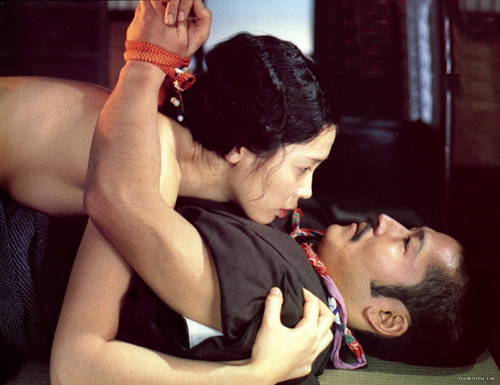 |
Like several of Oshima other films, Ai no corrida was based on a real news item, a documented sensational event, which provoked Oshima into creative mode. He is clearly interested in exploring sexual relations as an arena of power play. Always a political filmmaker, he is not content with affronting the censors. His film traces the empowerment of a woman of low social status, and the reversal of roles between master and servant. The castration of her master-lover is prefigured early, when she is shown wielding a knife in a brawl in the servants' quarters, and the relentless build-up to the climax makes it seem inevitable. He becomes increasingly more passive, she increasingly more aggressive and demanding. At the obscenity trial, in 1978, Oshima claimed the film was speaking for Sada and the rights of all subaltern women. But this film is no simple celebration of either womanpower or the desires of subaltern women. Sada's facial expression assumes more and more demonic elements, towards the end of the film; if the film is endorsing her power, it would also seem to be endorsing fear of women and the threat of castration by them. This is not a love story. Sada is intent on satisfying her desire and ultimately it is the penis alone that she craves and needs to service that desire, a human dildo rather than a man. But the penis that she triumphantly severs from its dead owner's body is an appendage of the male body, and in that sense the film could be said to celebrate fetishization of the phallus. In old rural Japan, as elsewhere, large stone phalluses were rubbed and worshipped as fetishes that embodied the hopes and desires of ordinary people for potency and fertility. When this film was produced, it created a storm of controversy, and encountered censorship problems in several countries, not just Japan. Its explicit treatment of sexual intercourse and its bloody castration scene outraged and disturbed viewers.
Now, 30 years later, it has become a classic, but not a cult classic apparently. But it definitely is a unique film. Not only one of the most courageous, provocative and daring erotic films in the history of cinema until now, but the proof, that erotic cinema can be cinema that challenges the viewer aesthetically, politically, emotionally and intellectually.
|